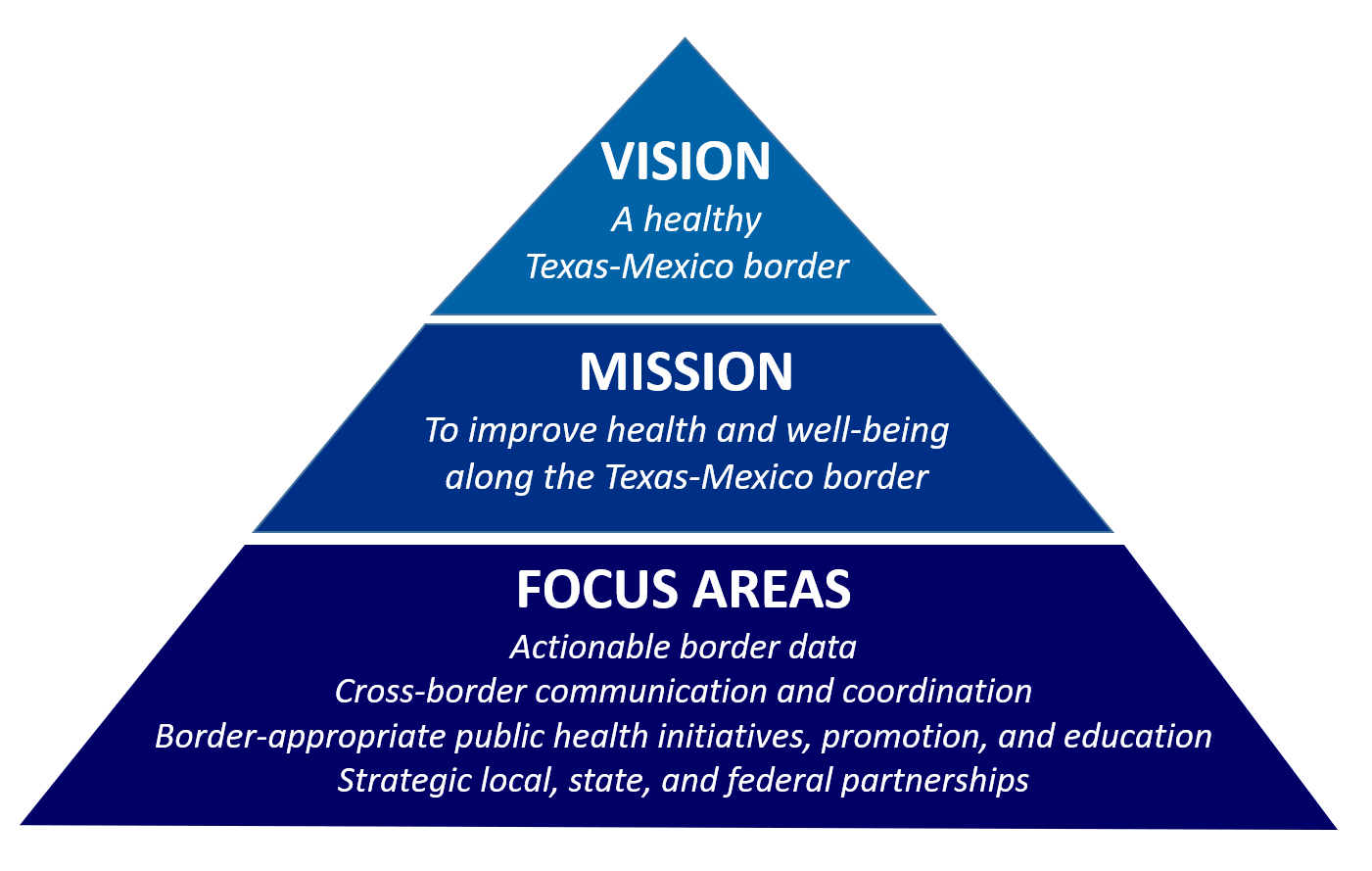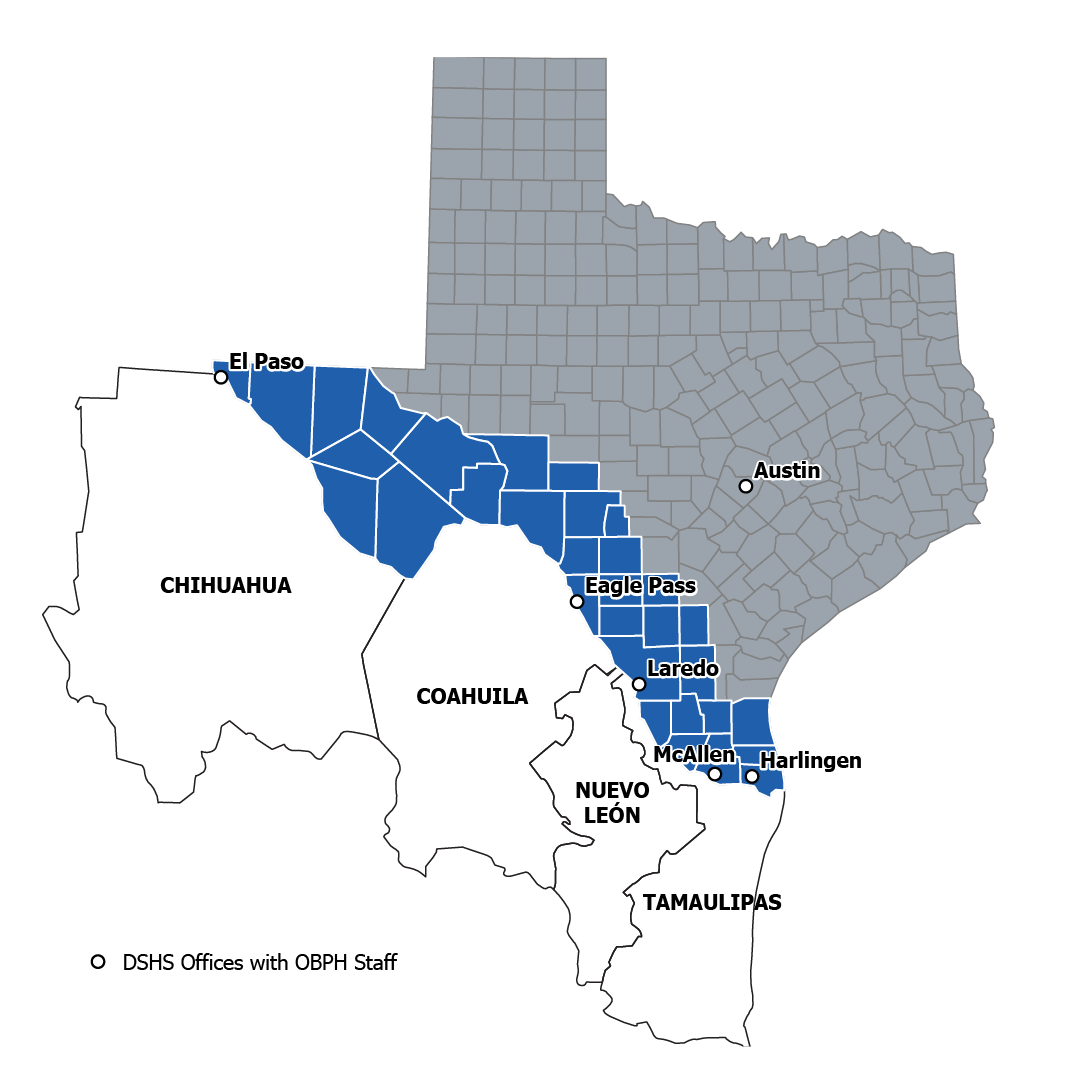Office of Border Public Health
This page provides information about Office of Border Public Health .
Regional and Local Health Operations
-
-
-
- Children with Special Health Care Needs (CSHCN) - Public Health Region 1
- Oral Health Services - Public Health Regions 1 and 2
- Drugs and Medical Devices - Public Health Region 1
- Emergency Medical Services (EMS) - Public Health Region 1
- Environmental Services - Public Health Region 1
- Manufactured Foods - Public Health Region 1
- Milk and Dairy Products - Public Health Region 1
- Meat Safety Assurance - Public Health Region 1
- Public Health Preparedness and Response - Public Health Region 1
- Community Health Improvement - Public Health Region 1
-
Public Sanitation and Retail Food Safety - Public Health Region 1 Open submenu links Close submenu links
- Radiation Control - Public Health Region 1
- STD and HIV Prevention - Public Health Region 1
- Epidemiology and Surveillance - Public Health Region 1
- Tuberculosis Elimination - Public Health Region 1
- Tobacco Prevention and Control Program - Public Health Region 1
- Texas Health Steps - Public Health Region 1
- Community Health Worker - Public Health Region 1
- Public Health Region 1 Contacts
- Public Health Region 1 Local Health Departments
- Public Health Region 1 Clinics
-
-
- Public Health Region 2/3 Local Health Departments
- Public Health Region 2/3 Clinics
- About Public Health Region 2/3
-
- Community Health Improvement Program - Public Health Region 2/3
- Environmental and Consumer Inspections Program - Public Health Region 2/3
- Epidemiology Program - Public Health Region 2/3
- HIV/STD Program - Public Health Region 2/3
- Immunizations Program - Public Health Region 2/3
- Public Health Emergency Preparedness and Response Program - Public Health Region 2/3
- Public Health Improvement Strategies & Operations Program - Public Health Region 2/3
- Public Health Nursing Program - Public Health Region 2/3
- Specialized Health and Social Services Program - Public Health Region 2/3
- Zoonosis Control Program - Public Health Region 2/3
- Public Health Region 2/3 Contact Information
-
-
- Environmental and Consumer Health Protection - Public Health Region 4/5N
- Epidemiology and Surveillance - Public Health Region 4/5N
- Health Facility Compliance Division - Public Health Region 4/5N
- HIV-STD Program - Public Health Region 4/5N
- Immunization Division - Public Health Region 4/5N
- Public Health Nursing Program - Public Health Region 4/5N
- Social Work Services - Public Health Region 4/5N
- Tuberculosis Elimination Program - Public Health Region 4/5N
- Zoonosis Control - Public Health Region 4/5N
- Community Health Services - Public Health Region 4/5N
- Oral Health Services - Public Health Regions 3, 4, and 5N
- Tobacco Prevention and Control - Public Health Region 4/5N
- Public Health Region 4/5 North Local Health Departments
- Public Health Region 4/5 North Publications
- Public Health Region 4/5 North Clinic Locations
-
-
-
- Community Health Services - Public Health Region 6/5 South
- Oral Health Services - Public Health Region 6/5 South and Region 7
- Environmental Health Services - Public Health Region 6/5 South
- HIV-STD Program - Public Health Region 6/5 South
- Epidemiology and Surveillance - Public Health Region 6/5S
- Immunization Program - Public Health Region 6/5 South
- Specialized Health & Social Services - Public Health Region 6/5 South
-
Tobacco Prevention and Control Program - Public Health Region 6/5 South Open submenu links Close submenu links
- Tuberculosis Elimination Program - Public Health Region 6/5 South
- Zoonosis Control - Public Health Region 6/5 South
- Public Health Region 6/5 South Clinic Locations
- Public Health Region 6/5 South Related Sites
- Public Health Region 6/5S Local Health Departments
- Public Health Region 6/5 South Events
-
-
-
- Specialized Health and Social Services - Public Health Region 7
- HIV-STD Program - Public Health Region 7
- Tobacco Prevention and Control - Public Health Region 7
- Epidemiology Program - Public Health Region 7
- Public Health Nursing - Public Health Region 7
- Regulatory Services Division - Public Health Region 7
- Tuberculosis Elimination Division - Public Health Region 7
- Vision and Hearing Services - Public Health Region 7
- Public Health Region 7 Field Office Locations
- Public Health Region 7 Local Health Departments
- Texas State Government Sites and Information
- Public Health Region 7 Resources
-
-
- Public Health Region 8 Public Health Organizations Offering Monkeypox Vaccinations
-
- Binational Esperanza y Amistad Tuberculosis Program - Public Health Region 8
- Office of Border Public Health - Public Health Region 8
- Community Health Improvement - Public Health Region 8
- HIV/STD Prevention - Public Health Region 8
- Immunization - Public Health Region 8
- Oral Health Services - Public Health Regions 8 and 11
- Preparedness and Response - Public Health Region 8
- Public Health Sanitation - Public Health Region 8
- Retail Food Safety - Public Health Region 8
- Specialized Health and Social Services - Public Health Region 8
- Texas Health Steps - Public Health Region 8
- Tobacco Prevention and Control - Public Health Region 8
- Tuberculosis Elimination - Public Health Region 8
- Zoonosis Control - Public Health Region 8
- Public Health Region 8 Office Locations
- Public Health Region 8 Local Health Departments
- Public Health Region 8 Local Health Authorities
- Public Health Region 8 Annual Reports
-
- Public Health Region 9/10 Data and Reports
-
- Case Management for Children and Pregnant Women - Public Health Region 9/10
- Children With Special Health Care Needs - Public Health Region 9/10
- Epidemiology - Public Health Region 9/10
- HIV/STD - Public Health Region 9/10
- Immunization Program - Public Health Region 9/10
- Oral Health Services - Public Health Region 9/10
- Personal Care Services - Public Health Region 9/10
- Preparedness and Response - Public Health Region 9/10
-
Retail Foods and Environmental Health Safety - Public Health Region 9/10 Open submenu links Close submenu links
- Texas Health Steps - Public Health Region 9/10
- Tuberculosis Elimination - Public Health Region 9/10
- Zoonosis - Public Health Region 9/10
- Public Health Region 9/10 Local Health Departments
- Public Health Region 9/10 Regional County Map
- Public Health Region 9/10 Offices and Clinics
- Public Health Region 9/10 Events
-
- Public Health Region 11 Local Health Departments
-
- Birth Defects Monitoring Division - Public Health Region 11
- Office of Border Public Health - Public Health Region 11
- Specialized Health and Social Services - Public Health Region 11
- Epidemiological Response Team - Public Health Region 11
- Community Health Services - Public Health Region 11
- General Sanitation Program - Public Health Region 11
- Immunization Program - Public Health Region 11
- Manufactured Foods Program - Public Health Region 11
- Meat Safety Assurance Program - Public Health Region 11
- Preparedness and Response Program - Public Health Region 11
- Radiation Control Program - Public Health Region 11
- TB Bi-National Project - Public Health Region 11
- Texas Health Steps Program - Public Health Region 11
- Tobacco Prevention and Control - Public Health Region 11
- Toxic Substance Control Division - Public Health Region 11
- Vision, Hearing and Speech Services - Public Health Region 11
- Zoonosis Control - Public Health Region 11
- Retail Food Safety - Public Health Region 11
- Tuberculosis Elimination Program - Public Health Region 11
- Operation Border Health (OBH) 2025
-
- Center for Health Emergency Preparedness and Response (CHEPR)
-
-
- Texas Local Public Health Organizations
-
Regional and Local Health Operations (RLHO) Community Health Worker (CHW) Coordination Open submenu links Close submenu links
- About Regional and Local Health Operations (RLHO) Community Health Worker (CHW) Coordination
- Community Health Worker (CHW) or Promotor(a) Training and Certification Program Frequently Asked Questions (FAQs)
- Regional and Local Health Operations (RLHO) Community Health Worker Training Center FAQs
- Training and Resources
-
Public Health Improvement - Preventive Health and Health Services Block Grant (PHHSBG) Open submenu links Close submenu links
- Contact Regional and Local Health Operations
Get in Touch
Get in Touch
Office of Border Public Health
1100 W. 49th Street
Austin, TX 78756-1962
United States
Office of Border Public Health
Our mission is to improve the health and well-being of the people living within the U.S.-Mexico border region by collaborating with partners and leveraging resources within and outside of Texas. The Office of Border Public Health (OBPH) builds community relationships to encourage a safe and healthy environment and lifestyle.
The OBPH:
- Tracks and shares data on public health issues and their impact
- Supports binational public health coalitions
- Conducts community-based initiatives
- Supports Community Health Workers (CHWs)
We believe that public health issues cross international borders and that the area along the U.S.-Mexico border is one epidemiological zone with shared health risk factors. We work together to keep Texas healthy by keeping our border healthy.
About the Mandate
In 1991, the 72nd Texas Legislature enacted the Health and Safety Code, Chapter 12,§12.071. The mandate stipulates, "The department shall establish and maintain an office in the department to coordinate and promote health and environmental issues between this state and Mexico.”
All four U.S. border states —Texas, New Mexico, Arizona, and California— have border health offices.
Vision
A healthy Texas-Mexico border
Mission
To improve health and well-being along the Texas-Mexico border.
Focus Areas
- Actionable border data
- Cross-border communication and coordination
- Border-appropriate public health initiatives, promotion, and education
- Strategic local, state, and federal partnerships
OBPH Principles

DSHS Border Area
The Texas Department of State Health Services (DSHS) border area is the area within 100 kilometers (or 62 miles) of the Rio Grande. This definition comes from the La Paz Agreement of 1983. It includes the 32 Texas Border Counties listed below.
The Texas DSHS Border Area

32 Texas Border Counties by DSHS Public Health Region
| West Texas (PHR 9/10) | South Central Texas (PHR 8) | South Texas (PHR 11) |
|---|---|---|
| Brewster | Dimmit | Brooks |
| Crockett | Edwards | Cameron |
| Culberson | Frio | Duval |
| El Paso | Kinney | Hidalgo |
| Hudspeth | La Salle | Jim Hogg |
| Jeff Davis | Maverick | Kenedy |
| Pecos | Real | McMullen |
| Presidio | Uvalde | Starr |
| Reeves | Val Verde | Webb |
| Sutton | Zavala | Willacy |
| Terrell | Zapata |
Physical Address
Texas Department of State Health Services Office of Border Public Health
1100 W. 49th Street
Austin, TX 78756-1962
United States